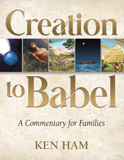
How Did Moses Know So Much About the Pre-flood World?
Is Genesis 2:10–14 Describing Place Names in Moses’ Time or Adam’s?
In Genesis 2:10–14, is Moses writing about the current landscape (i.e., the one in his time period, during the wilderness wandering), or is Moses using an apparent anachronism here?1 The garden was pre-flood, but Moses was not. He was writing to a post-flood Israel about the history of the world. Most likely, Moses either received direct, divine revelation regarding events and people he didn’t have direct access to or was copying written records from Adam (the book that was recorded in Genesis 5:1), or maybe he had oral tradition that was passed down through Shem’s line.

Image from Patterns of Evidence: The Moses Controversy.
If Moses was using a written record, then this would have been finalized before Adam died and likely passed along to his son Seth (as he was the only named son after Cain and Abel and seems to have occupied a prominent place in Adam’s life, per Genesis 5:3–4). Therefore, this could have been written up to 930 years after creation. By that time, landmarks and natural features had been named for people. Keep in mind that Methuselah (eighth generation, including Adam) was alive concurrently with Adam for some time, so there were many names to choose from to give place-names or natural feature names by this point. In time, this narrative, written and/or verbal, would have been passed down to Noah (Genesis 6:9).
Why Is There a Breakup of the Creation Narrative in Genesis 2:10–14?
Genesis 2:10–14 is a parenthetical portion: the narration from Genesis 2:9 is interrupted with some geographical bearings for the pre-flood reader (recall that Adam lived to see seven generations of descendants), then resumes in Genesis 2:15 with day six of the creation narrative, specifically Adam being placed in Eden by God. Moses wrote the description of Eden and the surrounding geography from the present-tense perspective of a pre-flood observer. It is possible this is because he was working from a pre-flood written record, maybe even preserving Adam’s own recollection of the landscape. Therefore, Genesis 2:10–14 is most likely a post-fall but pre-flood geographical description, which was dutifully recorded by Moses without changing the verb tense.
Had Moses been speaking of a pre-fall landscape, how would Adam (created minutes or hours before) have known where the rivers went? Why would the land of Havilah, Cush, and Asshur have been named when there was no one (except God) to name them? Why would the rivers be named, and for whom or what were they named if Adam had just been created? Obviously, this is not a day six creation narrative (unless God gave place-names to other portions of the world as he might have done with Eden, but there is nothing in the text to indicate this, nor why he would tell this information to newly-created Adam). This passage, therefore, appears to be parenthetical and anachronistic. Note as well, there is nothing in the text to indicate that the fall directly caused changes to the landscape as the global flood did.
Problems with the Passage Being Written During and About Moses’ Post-flood Lifetime
The geography does not fit post-flood Mesopotamia, and the names do not all align.
There are other problems with the suggestion that Moses recorded post-flood names for geographical landmarks because the pre-flood ones were either identical or geographically proximate. The geography does not fit post-flood Mesopotamia, and the names do not all align. Phrat and Hiddekel were already known as the Euphrates and Tigris (respectively) in Moses’ time (Deuteronomy 1:7, 11:24). Pishon and Gihon are unknown, and the land of Havilah was probably the same as that called Sheba in Abraham’s time, per Genesis 25:1–4, 18 (and likely known as such by Moses since he also wrote Genesis 25).
Let’s examine the whole passage of Genesis 2:10–14 in depth. First, we’ll look at the ESV and then the YLT to note the differences.
A river flowed out of Eden to water the garden, and there it divided and became four rivers. The name of the first is the Pishon. It is the one that flowed around the whole land of Havilah, where there is gold. And the gold of that land is good; bdellium and onyx stone are there. The name of the second river is the Gihon. It is the one that flowed around the whole land of Cush. And the name of the third river is the Tigris, which flows east of Assyria. And the fourth river is the Euphrates. (Genesis 2:10–14 ESV)
Note the difference in the YLT below, which is a literal translation, taking the Hebrew words and transliterating them directly into English. (In other words, Assyria and Ethiopia are translations of the Hebrew; whereas, Asshur and Cush are transliterations.)
And a river is going out from Eden to water the garden, and from thence it is parted, and hath become four chief rivers; the name of the one is Pison, it is that which is surrounding the whole land of the Havilah where the gold is, and the gold of that land is good, there is the bdolach and the shoham stone; and the name of the second river is Gibon, it is that which is surrounding the whole land of Cush; and the name of the third river is Hiddekel, it is that which is going east of Asshur; and the fourth river is Phrat. (Genesis 2:10–14 YLT)
The flood destroyed the world as Noah knew it.
The flood destroyed the world as Noah knew it (see 2 Peter 3:6), covering the original garden under thousands of feet of sediment. So the rivers flowing out of Eden, including the two called the Tigris and Euphrates (Genesis 2:14), cannot be the same rivers today. Also, the modern rivers come from different sources and then merge, whereas Eden’s rivers came from one source and then divided into four rivers.
Post-flood Interpretations Don’t Match the Text
Earth’s entire topography would have been completely reworked.
As mentioned above, the post-flood landscape would have been vastly different than the pre-flood world. Many Christians make the mistake of assuming the garden of Eden existed in the Middle East between the Tigris and Euphrates rivers. After all, they reason that Genesis 2:14 mentions both of these rivers. The problem with this view is that Genesis 2 says that one river went out of the garden and then was divided into four rivers, two of which were called the Tigris and Euphrates. The other two rivers were called the Pishon and the Gihon (Genesis 2:10–13). Nothing in the Middle East matches this geographical description. This is problematic for those who believe in a local flood but is what one should expect if the whole world was destroyed by water. Earth’s entire topography would have been completely reworked.
The question naturally arises as to why the Tigris and Euphrates are now named as they are. There is an easy explanation for this. After leaving the mountains of Ararat, the post-flood settlers would have named places and landmarks based on what they already knew. This is the same reason that the United States has places named York (Pennsylvania), Moscow (Idaho), Paris (Kentucky), and Plymouth (Massachusetts), etc. These cities were named after places familiar to emigrants from England, Russia, and elsewhere. It makes perfect sense that those settling the world after the flood would have done the same thing.
So, if someone accepts Genesis 2:14 as speaking of Assyria in Iraq, then they also have to accept 2:13 as speaking of Ethiopia/Sudan/Southeast Libya and 2:11 as speaking of Havilah in the Arabian Peninsula. Therefore, Eden would have to be the size of about 3,500 square miles, and the eastern border (Genesis 2:8) of this region would not be in Iraq but, today, would be in Oman on the Arabian Peninsula, and the western border would have likely been in Libya. We also know full well that no rivers today start in Iraq and flow into Africa, so these cannot be the same rivers that are spoken of. However, it is much more likely that Cush and Asshur were pre-flood names of places (perhaps based on pre-flood people not named in Genesis 1–6) unrelated to the later post-flood names. In fact, the later post-flood names may have borrowed these in honor of the pre-flood ones. Moses simply recorded these pre-flood names (through direct, divine revelation) as an apparent anachronism, or he copied down and edited records recorded by Adam (and other pre-flood patriarchs).
What About the Toledoth Hypothesis?
Some theologians believe that the pre-flood and post-flood patriarchs wrote down their own narrative parts of Genesis. In short, Moses compiled historical records recorded from the time of the first man, Adam, down through Jacob and then from Jacob’s son, Joseph. At the time of the Exodus, or shortly thereafter, these records were probably given to Moses from the tribe of Ephraim or Manasseh, when the bones of Joseph were entrusted to Moses (Exodus 13:19).
It should be noted that it is possible that Genesis was a book that was written over several thousand years. If that is the case, then most likely these written (or possibly oral) records were passed down from father to son until they reached Moses, who compiled, edited, and rewrote them into the book of Genesis found in the Hebrew Bible. Although it must be admitted that some YEC Bible and Hebrew scholars dispute this hypothesis.2 But we must recognize that there are really only two ways Moses could have known about things which occurred long before he lived, either through direct revelation or from written (and/or possibly oral) records.
How do we know the written tablets model which Moses may have edited is a possibility? The first is a listing of toledoths in the Hebrew (translated into English as “these are the genealogies/generations of”), which imply a signature of the person who just finished writing that section of the book. Of course, none of the original biblical manuscripts, including the book of Genesis, are extant, but if this hypothesis is correct (and it has been adopted by several young-earth creationist theologians), then it means that the finger of God wrote down the first two chapters of Genesis and then directly told Adam, who then recorded some of the events of later verses in Genesis 2.
Just as in the New Testament, we see different writing styles among the apostles, but all are guided by the Holy Spirit.
Also, according to this hypothesis, some theologians and scholars believe that this was Adam’s account running from Genesis 2:4 through Genesis 5:1, at which point Adam passed the book (and the Hebrew word here is סֵפֶר [cepher], which is usually translated as “scroll” or “book”) to his son Seth and then down the line of sons. Therefore, as stated above, when Genesis 2:10 states that a river went out from Eden in the present tense, it is because Adam wrote it as he saw it, and when Moses compiled the records, he did not change the verb tenses. Just as in the New Testament, we see different writing styles among the apostles, but all are guided by the Holy Spirit. So Adam recorded things differently from Noah, who recorded things differently from Shem, who recorded things differently from Jacob. Each with their own personality but guided inerrantly by the Holy Spirit. See Table 1 below for a listing of all the toledoths.
| Beginning | End | Probable author of original work from which Moses drew |
|---|---|---|
| Genesis 1:1 | Genesis 2:4a | Adam by direct, divine revelation, so not connected with Adam’s name |
| Genesis 2:4b | Genesis 5:1a | Adam |
| Genesis 5:1b | Genesis 6:9a | Noah |
| Genesis 6:9b | Genesis 10:1 | Shem, Ham, and Japheth |
| Genesis 10:2 | Genesis 11:10a | Shem |
| Genesis 11:10b | Genesis 11:27a | Terah |
| Genesis 11:27b | Genesis 25:12a | Abraham |
| Genesis 25:12b | Genesis 25:19a | Ishmael |
| Genesis 25:19b | Genesis 36:1a | Esau |
| Genesis 36:1b | Genesis 36:9a | Esau or Jacob |
| Genesis 36:9b | Genesis 37:2 | Jacob |
| Genesis 37:2b | Genesis 50:26 | Joseph |
Conclusion
The best explanation for Genesis 2:10–14 is that it is not disjointed but a “road map” for people of Adam’s time.
Whether through direct, divine revelation or from written or oral records (accurately preserved by the Holy Spirit), Moses had access to knowledge about creation week and human history up through the time of Joseph and his sons Ephraim and Manasseh. Therefore, the best explanation for what seems to be the disjointed insertion of Genesis 2:10–14 is that it is not disjointed but a “road map” for people of Adam’s time. Having lived 930 years (and many of his descendants living the same or longer), Adam stops the creation narrative and explains to people who probably now lived nowhere near Eden where it was in relation to other then-present-day landmarks. Adam is anticipating the question of “where was Eden located” by his younger contemporaries, and this would be especially true if the book or scroll (cepher) Adam is writing was meant to be reread by Shem and his sons. Then after providing a brief road-map response, Adam resumes writing about day six of creation week.
Imagine that you were describing your hometown to a friend who was born hundreds of miles away and moved to where you live now. You might stop your description and think to yourself that you would first need to give him some geographical information so he could conceptualize the area (for example, if you were born in Plymouth, Indiana, you might say, “It’s midway between Chicago and Ft. Wayne”). This appears to be the same thing that Adam did and makes much more explanatory sense of this seemingly disjointed text than other postulations (with the exception of direct revelation).
Footnotes
- Webster’s second definition of anachronism is the one most pertinent here: “a person or a thing that is chronologically out of place, especially: one from a former age that is incongruous in the present.” https://www.merriam-webster.com/dictionary/anachronism.
- Lee Anderson, “A Critical Evaluation of the Tablet Model: Considerations on the Origin of the Book of Genesis,” CRSQ 54, no. 1 (Summer 2017): 5–26.
- For additional information on the Toledoth hypothesis (from which Table 1 above was taken), please see: http://www.answersingenesis.org/articles/2011/06/28/did-moses-write-genesis.
Recommended Resources

Answers in Genesis is an apologetics ministry, dedicated to helping Christians defend their faith and proclaim the good news of Jesus Christ.
- Customer Service 800.778.3390
- © 2024 Answers in Genesis





